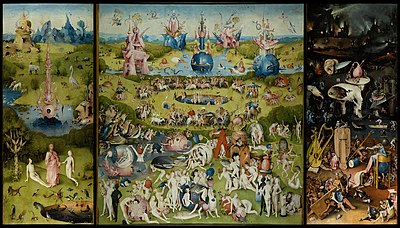
Back Art fantastique French Arte fantastica Italian 幻想絵画 Japanese Seni fantasi Malay Fantastische kunst Dutch Arte fantástica Portuguese Arta fantastică Romanian ศิลปะอัศจรรย์ Thai Фантастичне мистецтво Ukrainian

Fantastic art is a broad and loosely defined art genre.[1] It is not restricted to a specific school of artists, geographical location or historical period. It can be characterised by subject matter – which portrays non-realistic, mystical, mythical or folkloric subjects or events – and style, which is representational and naturalistic, rather than abstract – or in the case of magazine illustrations and similar, in the style of graphic novel art such as manga.[citation needed]
Fantasy has been an integral part of art since its beginnings,[2] but has been particularly important in mannerism, magic realist painting, romantic art, symbolism, surrealism and lowbrow. In French, the genre is called le fantastique, in English it is sometimes referred to as visionary art, grotesque art or mannerist art. It has had a deep and circular interaction with fantasy literature.[citation needed]
The subject matter of fantastic art may resemble the product of hallucinations, and Fantastic artist Richard Dadd spent much of his life in mental institutions. Salvador Dalí famously said: "the only difference between me and a madman is that I am not mad".[3] Some recent fantastic art draws on the artist's experience, or purported experience, of hallucinogenic drugs.
The term fantasy art is closely related, and is applied primarily to recent art (typically 20th century on wards) inspired by, or illustrating fantasy literature.[citation needed]
Fantastic art has traditionally been largely confined to painting and illustration, but since the 1970s has increasingly been found also in photography. Fantastic art explores fantasy, imagination, the dream state, the grotesque, visions and the uncanny,[2] as well as so-called "Goth" and "Dark" art.
- ^ Cite error: The named reference
jahsonicwas invoked but never defined (see the help page). - ^ a b Schurian, Walter (2005) Beyond Mere Understanding. In: Fantastic Art, Schurian, W. & Grosenick, U. (Ed.), Taschen, p.6-25. ISBN 978-3-8228-2954-7 (English edition)
- ^ "thinkexist.com". Archived from the original on 4 August 2013. Retrieved 4 August 2013.
© MMXXIII Rich X Search. We shall prevail. All rights reserved. Rich X Search